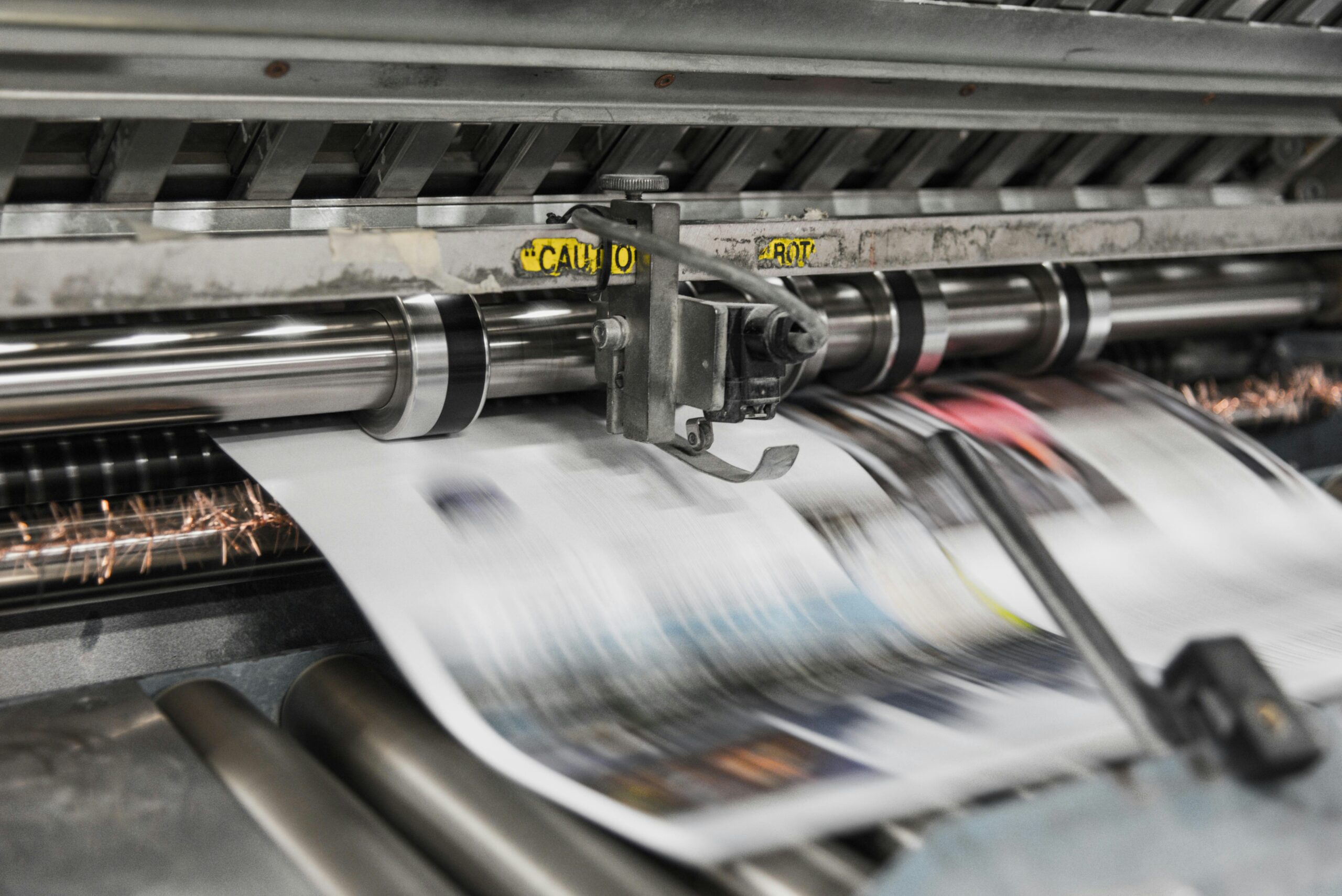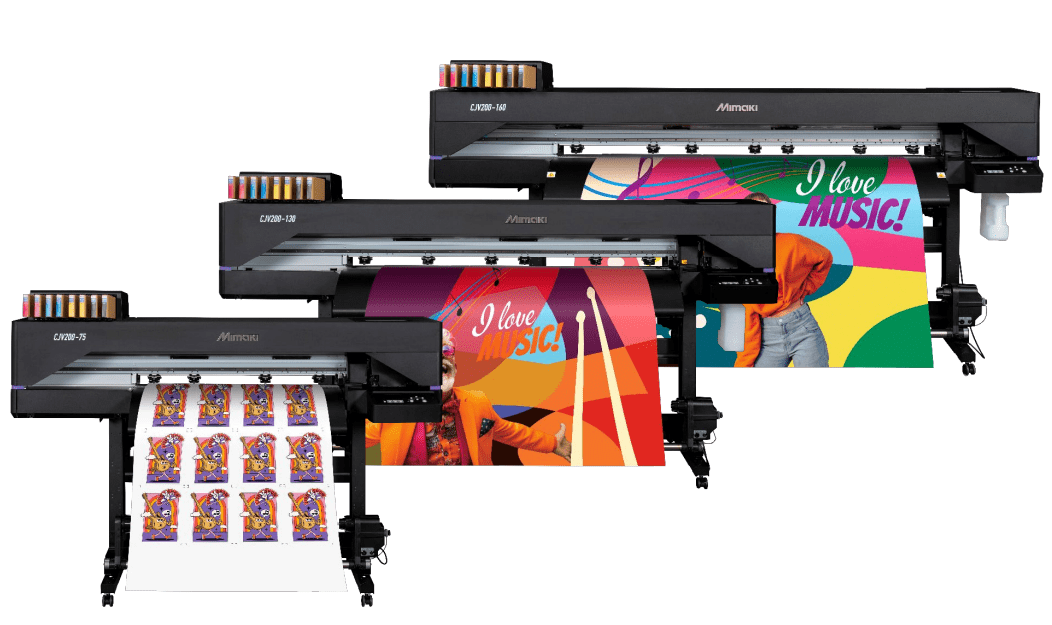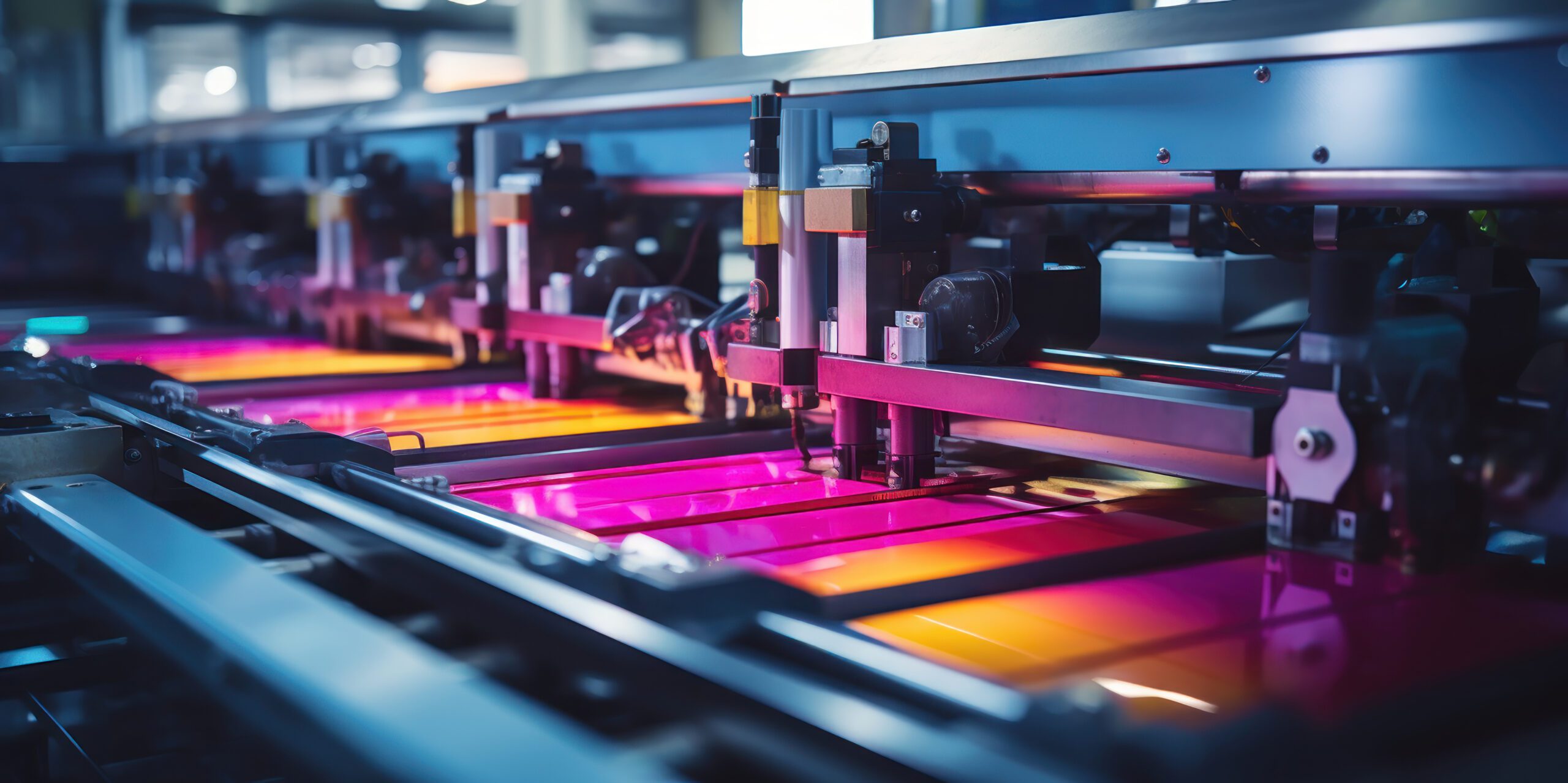Why is print finishing so critical to any printer? What are your print handling and finishing equipment options? And how should you go about choosing what’s right for your business? In this Soyang guide, we’ll explain.
Table Of Contents:
- What Is Print Finishing?
- Why Does Print Finishing Matter?
- Print Coatings & Finishes Explained
- How to Choose Print Finishing Equipment
- Print Finishing Equipment Options
- Print Handling Equipment
1. What Is Print Finishing?
Print finishing: because printing is only half the story…
Every print shop knows that, for a completed banner, vehicle wrap, report, brochure or flag to be customer-ready, you need to do more than merely print it.
Printing takes the product as far as the output tray. But there are very few print jobs that will become invoiceable at that point. To complete the job, you’ll probably need one or more of the following:
- Coating
- Curing
- Collating
- Cutting
- Embossing
- Perforating
- Stapling
- Binding
- Laminating
All of the above are print finishing processes. Print finishing is the part of the printer’s job where all their skill, experience and attention to detail come to the fore. After all, most businesses have the capability to print something. But few have the ability (or the equipment) to deliver print that creates a powerful impression and delivers a lasting impact.
In a very real sense, without the finishing, print simply isn’t finished.
2. Why Does Print Finishing Matter?
It’s far more than a nice-to-have finishing touch. Finishing is fundamental to product quality and business success.
It’s what makes you money: If you’re asked to print a report, the job isn’t done until the pages are collated and bound. A banner isn’t complete without taped seams and eyelets that make it useable and robust. And a brochure, magazine or business card isn’t finished until you’ve laminated, varnished or embossed it.
Simply put, you can’t invoice for a job that isn’t finished.
It’s why customers choose you: There are lots of reasons customers choose and then stay loyal to a printer. Price. Turnaround times. Your expertise when a customer is unsure which print option would be best. They all influence a buyer’s decision-making process.
One of the most important factors is finishing, although industry research suggests this is a multi-faceted issue. There’s your capacity to physically offer the print finishing services a customer requires. There’s the variety of print finishes you are capable of producing. And there’s the quality of the finishing you can produce relative to your competitors.
Ultimately, the greater your print finishing capability, the more business you’ll win.
It’s what enables your print to do its job
In one of its meanings, print finishing describes the practical, physical processes that enable a piece of print to perform the function you need of it. A book isn’t a book until it’s been bound, for example. A banner isn’t a banner until you’ve added the elements that will enable it to be fixed in place and survive the elements.
It’s what makes marketing ‘pop’
The alternative meaning of print finishing describes the techniques applied to a piece of card, paper, acrylic or vinyl that create visual impact. This type of finish is the sort of thing that can be the difference between a promotional mailer, business card or brochure that grabs the attention long enough to deliver its message and one that doesn’t. We explore this further below.
3. Print Coatings & Finishes Explained
If the print finish you’re after is all about visual impact, what are your options?
Until you’ve applied a finish to it, a piece of card or paper is, well, just a piece of card or paper. Lifeless. A little dull.
With the right finish, however, you can lift the design and bring the print to life. When you do that, your print products will deliver a lot more impact. There’s a huge range of print finish types to choose from, but the most common (and effective) include:
- Lamination: A thin layer of film applied to the print surface which, in addition to making the item more robust, durable and harder to tear, creates a gloss, matt or satin sheen that makes colours extra sharp and vibrant (in the case of gloss) or adds sophistication and reduces reflection (matt and satin).
- Embossing and debossing: Two separate techniques (you might know debossing as letterpress) where parts of the print are raised or depressed so they sit proud of or below the main surface of the page. An excitingly tactile finish, and one that can be further enhanced by combining with some of the other techniques in this section.
- Varnishing: Similar to lamination in that it coats the print and can be a gloss, matt or satin finish. Unlike lamination, however, this isn’t a film but a liquid which means you can apply it to parts of a page (spot varnishing) and not others. It’s a great way to draw the eye to specific design motifs or information.
- Foiling: A metallic coating, typically applied to elements of a printed card or page (it works well in lettering or, for example, as a seal on a certificate). Often used in combination with embossing or debossing.
- Die-cutting and laser cutting: Die cutting is the more traditional print cutting technique and is ideal for cutting print to shape. You might use it to round the corners of a business card or cut a window in a wedding invitation. Laser cutting enables far more intricate cuts, and can create powerful design flourishes in greetings cards, invitations, POS materials etc.
If a significant proportion of your work is this sort of finishing, printing equipment could help you do it faster and more cost effectively. We explore this more below.
Related Article: A Guide to Digital Printing Coating Options
4. How to Choose Print Finishing Equipment
How do you select the print handling and finishing equipment that will deliver biggest bang for your business’ buck?
As we’re about to discover, the list of possible print finishing equipment options is long. All of it could benefit your print shop, but few businesses will have the resources (or space) to invest in everything. So how do you choose the print and finishing equipment that will really deliver bang for its buck? We’d suggest considering the following questions.
1. What’s the demand?
Perhaps the simplest and most obvious way to determine which new finishing equipment you need is to keep a record of the occasions you’re asked for a service you don’t/can’t currently offer.
It’s important not to simply react to a single request (or even multiple requests) for a service by going out and investing in a new piece of equipment in a knee jerk way. You still need to assess the cost benefit and other factors (see below), but this can be a valuable way of gauging customer interest.
2. What’s the current cost burden?
Before you can work out the cost/benefit of any new finishing equipment, you’ll want to understand how a lack of that equipment is currently affecting you. Here’s an example:
You’re weighing up buying a flatbed applicator (see below). Currently, you’re dealing with a growing number of projects where you’re expected to laminate large and thick substrates. With your current roll laminator, each job takes time and, ideally, it needs two people to keep things straight. You’re also noticing that you’re having to redo more work than you’d like.
The cost burden of keeping the status quo, therefore, will be:
- The wages of an additional member of staff
- A slower pace of production
- The time and staff resource cost of increased rework
- The materials consumed as a result of rework
By assigning a figure to each of the above, you’ll be better able to compare the cost benefit of doing something with the cost burden of doing nothing.
3. What’s the cost/benefit?
Any piece of print finishing equipment costs money. What matters, however, is how quickly the equipment will pay for itself, and by how much the cost benefit will outstrip the cost burden.
Looking again at the above example, a flatbed applicator could enable just one person to produce several times the output they would be able to achieve using existing kit. It would enable you to increase productivity without increasing wages.
The additional advantages offered by the applicator would also reduce rework requirements.
So while the cost of the applicator may run to several thousand pounds, the investment would pay for itself in just a few months and would far outstrip the cost burden of doing nothing.
4. How often will it be used?
A crucial part of the cost/benefit equation is use frequency. A laser cutter may enable you to make intricate cuts to the POS material you produce, but if you only deliver a handful of such projects each year, you might be better off finding an alternative way of delivering the project using equipment you’ll use more often.
If you’re faced with investing heavily in a piece of print finishing equipment or not being able to manage certain types of projects cost effectively, you have a choice: either forego those types of projects or ramp up marketing for such work so you can bring in more commissions to make the investment worthwhile.
5. What are the alternatives?
While the lack of a laser cutter, for example, may limit some of your finishing capabilities, if you already offer embossing, foiling, varnishing and more, you may find it simpler (and much cheaper) to suggest finishing techniques you’re already equipped to deliver.
6. Print Finishing Equipment Options
Flatbed Applicators
A large flatbed applicator can do wonders for your print shop’s productivity, reducing the time, effort and even the number of people required to complete your large mounting and lamination jobs.
The uniform pressure applied by the roller also means fewer bubbles (and therefore less rework), while the ability to handle thick substrate means you can take on exhibition boards, panels and other niche projects.
Arguably the largest piece of finishing equipment you’re likely to invest in, but also potentially the most cost effective.
Roll Laminators
The key to choosing the right roll laminator is document size. That’s not just the length and width of the product you’re aiming to print, but its thickness.
Even the most entry level print shop roll laminator should be capable of delivering speedy, versatile lamination. Invest more, however, and you’re likely to find your laminator can handle thicker substrate and deliver a top-quality finish (for example, by eliminating the risk of ‘silvering’ caused by too much pressure on sensitive laminates).
Cutting Systems
‘Cutting’ is a short word for perhaps the most wide-ranging type of print finishing equipment. Vinyl cutters, die cutters, contour cutters, laser cutters and engravers – whether you need a trusty straight edge for your posters and banners or the most intricate cutting capability for signage and graphics, there’s a machine that can make the job quicker and easier.
There are numerous elements to choosing the right cutter, but the starting point in deciding where to put your money has to be comparing the print products you produce with the equipment available.
You’re unlikely to find a single piece of equipment that can do everything you need, but you may find research and some careful investment could limit expenditure to just a couple of multi-functional machines.
Here, perhaps more than with any other piece of print and finishing equipment, it’s worth seeking expert advice.
Embossing & Foiling
You’ll need a stamping machine to emboss or deboss a product and, depending on the type of machine you choose, that may well include the ability to add foil. Heavier duty models offer precision and durability and can often be used to emboss promotional materials (leather keyrings, wooden pencils etc) as well as paper and card.
Print Collators
Before you can bind multi-sheet print documents, you need to collate the sheets and — crucially — ensure those sheets are in the right order. Print collators do that automatically, so that when the finished report, book or brochure reaches the end user, every page is where it should be.
Print Binders
Not something you’ll find in every print shop, but if your business spends much of its time dealing with reports, brochures, magazines or books, you might want to invest in a binding machine.
Inevitably, your choice of equipment will be driven by the type of binding you need to do, from the fine saddle stitching of a book cover to the more functional power of wire, coil or comb binding.
Keencut Cutters
We’ve already looked at cutting equipment, but those were largely creative cutting tools — the sort that will round edges, create carefully designed cut-outs or shape lettering.
Just as vital to the printer’s finishing process is the ability to make neat, clean, accurate cuts along paper and vinyl that don’t require additional trimming, because that’s what turns finishing into a laborious and costly process.
There are many ways to achieve that. We do it through Keencut cutters.
7. Print Handling Equipment
There’s one crucial omission in the above range of print finishing equipment. When a quality product requires quality (and frequently heavy) print materials, you’ll need a way of safely, securely transporting and storing them.
This is the role of print handling equipment.
You’ll often see the term ‘print handling’ used interchangeably with print management (that is, the software systems used to support your print shop workflow). In terms of print and finishing equipment however, printing handling has a distinct meaning. It’s the kit that helps you lift and move print materials around the print shop.
Why printing handling equipment matters
The right racks, lifters and transporters aren’t just important in terms of preventing your people from injuring themselves as they try to move large media rolls; they’re also vital in protecting those materials, so papers and vinyls don’t get torn, snagged or deformed as they are unspooled.
Without the right handling equipment, your print shop risks wasting money on materials that get damaged before you have a chance to use them.
Types of print handling equipment
- Bull racks: Mount large format print materials and use them straight from the roll.
- Lifters: The simple, secure and back-friendly way to lift and carry media rolls around your print shop.
- Rollers: Essential for safely transporting large, rigid materials (eg board and acrylic sheets) around the workplace
- Jumbo roll transporters: As the names suggests, a type of heavy-duty transporter that’s not only able to carry the largest media rolls, but also helps to avoid deformation.
For Print and Finishing Equipment, Talk To Soyang
At Soyang, you’ll find a wide variety of print handling and finishing equipment to not only help you create professional, precise, long-lasting prints and signs, but do it more efficiently and cost-effectively.
Explore our full range of printing finishing equipment, or talk to us










